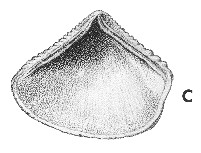
Revised descriptions of New Zealand Cenozoic Mollusca from Beu and Maxwell (1990)

 | Revised descriptions of New Zealand Cenozoic Mollusca from Beu and Maxwell (1990) | 
|
  (Pl. 12c): GS9806, F45/f9668, Shell Gully, Chatton, Duntroonian (GNS) |
  (Pl. 12f): GS9806, F45/f9668, Shell Gully, Chatton, Duntroonian (GNS) |
Beu & Maxwell (1990): Chapter 10; p. 152; pl. 12 c, f.
Synonymy: Myadora delta Marwick 1929, p. 914
Classification: Myochamidae
Description: Rather small for genus (length 7-10 mm), triangular, subequilateral; strongly inequivalve, right valve inflated, left valve almost flat or concave and twisted. Both valves with long, sharply denned lunule and escutcheon almost perpendicular to remainder of valve exterior; right valve with slightly concave posterior area. Sculpture on left valve of short, prominent commarginal ridges along anterodorsal margin, rest of shell with weak growth ridges or almost smooth. Right valve with similar ridges along both dorsal margins, central area smooth except for a few growth ridges in some shells, but others with ridges continuous across central area. Both valves with squamous microsculpture of minute tesserae. Interior nacreous. Both valves with dorsal margins prominently grooved along most of their length; resilifer narrowly triangular. Pallial sinus very shallow.
Comparison: The right valve from Burnt Hill, North Canterbury (Waiauan) recorded by Marwick (1932, p. 499) as this species is more elongate and has more prominent commarginal sculpture than topotypes, but Beu (2006) recorded more typical valves from Burnt Hill, as well as specimens as young as late Miocene. Beu (2006, fig. 40) illustrated specimens and compared them with the similar Nukumaruan-Recent species M. novaezelandiae Smith, 1881. M. delta is a more extremely flattened and triangular, sharply angled species than M. novaezelandiae, which is similar in size and general appearance, but is also "plumper" and more coarsely scuptured than M. delta.
Myadora delta is the oldest known member of the genus in New Zealand, differing from all younger species in its small size, equilateral triangular shape, and weak commarginal sculpture. It belongs to a group of similar, small, strongly triangular species that lives today throughout the Indo-West Pacific province, as far north as southern Japan.
Distribution: Duntroonian-Tongaporutuan/Kapitean? (Beu 2006, p. 311-312); Chatton Formation, Shell Gully, Chatton, Duntroonian (type) (common); Wendon Valley; Wharekuri Greensand, Wharekuri; Brother's Stream, Hakataramea Valley; Mount Harris Formation, foot of Mt Horrible, Pareora River; Awamoa Creek; Ardgowan Shellbed, Oamaru; Weka Pass Stream, Waiauan; Burnt Hill, near Oxford, N Canterbuty, Waiauan; hill between Te Araraoa and Awatere River, near East Cape, Tongaporutuan/Kapitean (Beu 2006).
Cite this publication as: "A.G. Beu and J.I. Raine (2009). Revised
descriptions of New Zealand Cenozoic Mollusca from Beu and Maxwell (1990). GNS
Science miscellaneous series no. 27."
© GNS Science, 2009
ISBN
978-0-478-19705-1
ISSN 1177-2441
(Included with a PDF facsimile file
copy of New Zealand Geological Survey Paleontological Bulletin 58 in CD version
from: Publications Officer, GNS Science, P.O. Box 30368 Lower Hutt, New
Zealand)